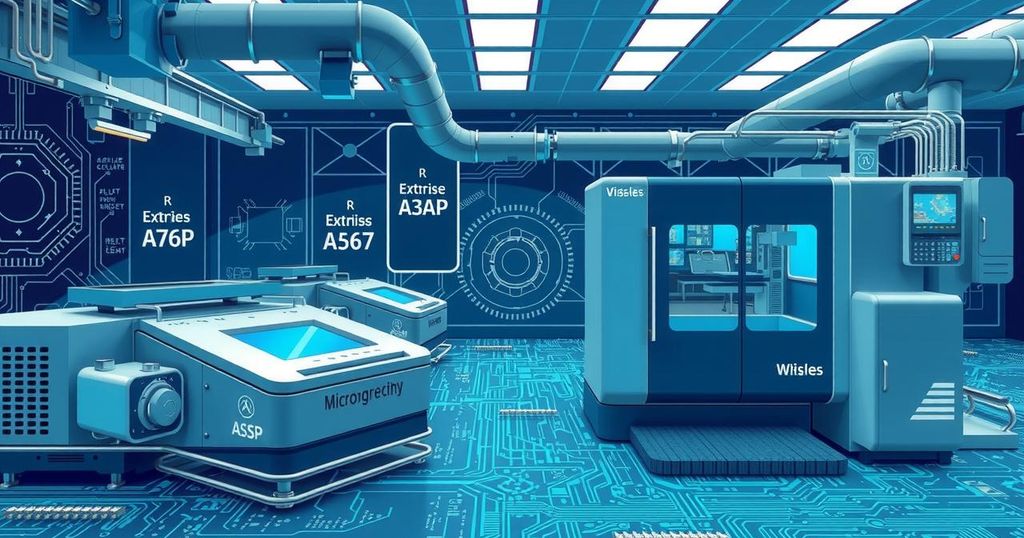Weekly News Roundup: Developments in China’s Semiconductor Industry and U.S. Influences

This article highlights major semiconductor industry developments, including China’s advancements in EUV lithography and proposals for anonymous semiconductor purchases to bypass US export controls. It discusses the strategic direction of Naura and Intel, forecasting significant shifts in global semiconductor manufacturing amid geopolitical tensions.
This article discusses significant events in the semiconductor industry as reported by DIGITIMES Asia during the week of March 10 to March 15. Notably, China is making advancements in extreme ultraviolet (EUV) lithography technology and is targeting a domestic solution through the development of a laser-induced discharge plasma (LDP) lithography system, with expectations of trial production by the third quarter of 2025 and mass production in 2026. China’s reliance on older methods was largely due to US export controls that have restricted access to ASML’s EUV machines.
Experts suggest that if China successfully commercializes its LDP-based EUV technology, it may minimize its dependency on foreign suppliers and could even challenge Western semiconductor firms. Key obstacles, however, include enhancing power output and manufacturing high-precision optical components. Huawei and SMIC are the frontrunners in this pursuit, with the potential for China to disrupt the semiconductor market significantly. Amid geopolitical tensions, the timeline for these developments may vary.
In another development, a Chinese lawmaker has proposed allowing blacklisted domestic firms to make anonymous procurements of foreign semiconductor technologies to circumvent US export restrictions. This proposition was presented by Wen-Hui Guan during the National People’s Congress, advocating private transactions over public tenders to protect suppliers. Current methods indicate that Chinese firms have been bypassing restrictions, leveraging intermediaries for technology procurement.
Naura Technology Group is also intensifying its efforts to close gaps in its semiconductor equipment supply chain, particularly in lithography. Despite advances in semiconductor processing, a lack of advanced lithography machines remains a challenge. Ongoing investments and a strategic focus on lithography-related equipment suggest a long-term commitment to bolster domestic semiconductor manufacturing capabilities.
In further news, Intel is anticipated to consider merging its foundry services with GlobalFoundries under incoming CEO Lip-Bu Tan. This strategic move could create a competitive entity within the US semiconductor landscape aimed at challenging TSMC’s dominance. There are indications of exploration into joint ventures, while pre-existing concerns regarding antitrust implications and management challenges could affect this trajectory.
Kioxia, a NAND flash manufacturer, projects an overall increase in NAND shipments by 10-15% in 2025, yet anticipates possible supply shortages in the latter part of the year, driven primarily by AI server demand. The company continues production growth without major cuts and is preparing for advancements with upcoming 218-layer and 332-layer NAND technologies.
Intel recently showcased its Panther Lake processor, prominently featured at Embedded World 2025. This processor exemplifies Intel’s commitment to enhancing AI computing power while adhering to the company’s five-node roadmap. With strong production progress indicated, Intel emphasizes its strategic goals to revamp its manufacturing capabilities, bolstered by support from the CHIPS Act.
In the context of ongoing US-China tensions, Naura has advanced to the sixth position among global semiconductor equipment providers. This growth illustrates China’s focus on self-sufficiency despite international impediments, as local foundries increasingly incorporate domestically produced equipment. While competitive challenges persist, expectations on Chinese semiconductor firms to improve their standing continue to rise as geopolitical dynamics evolve.
The article was edited by Jerry Chen, providing insights into the dynamic landscape of the semiconductor industry.
In conclusion, the semiconductor industry is seeing notable developments, particularly in China with advancements in EUV lithography technology and legislative proposals aimed at circumventing US sanctions. Companies like Naura are strengthening their equipment supply chains, while Intel is poised for strategic shifts under new leadership. Despite geopolitical challenges, the market is evolving, and these movements indicate a potential reshaping of global semiconductor dynamics.
Original Source: www.digitimes.com




